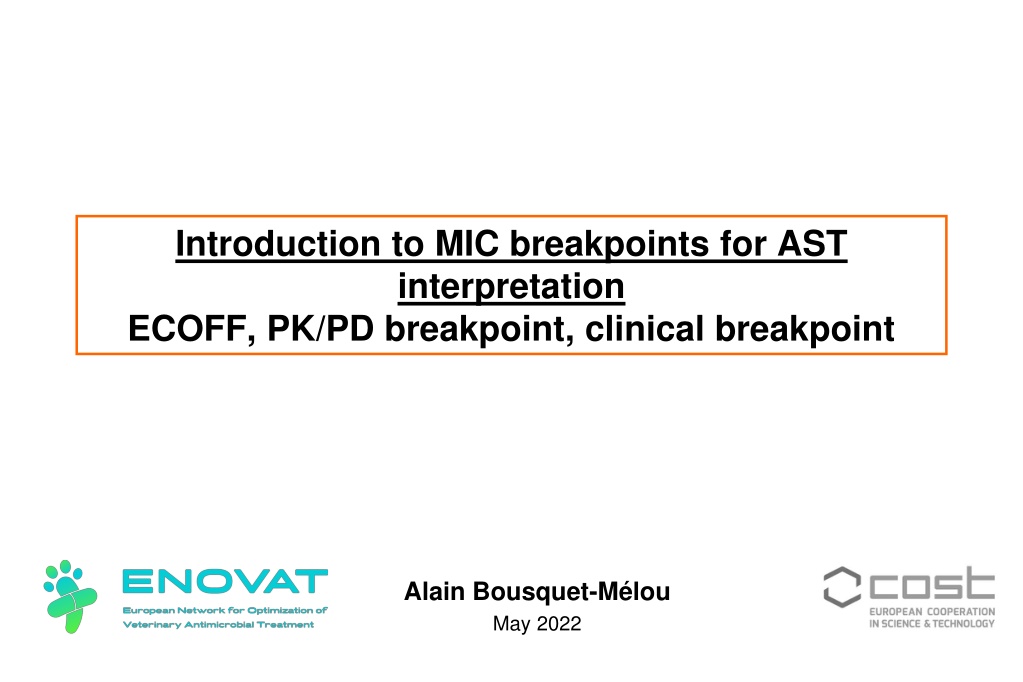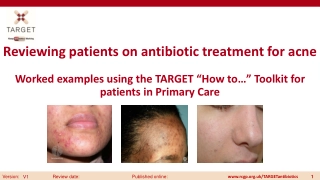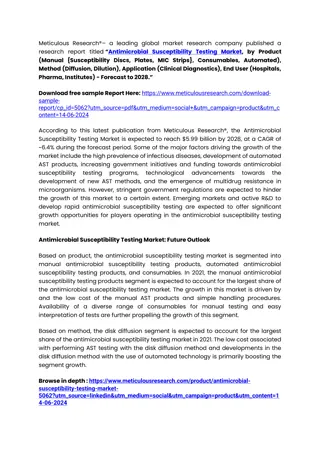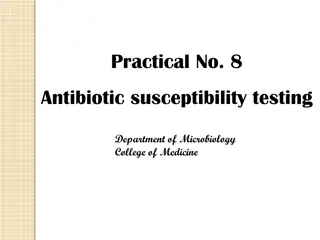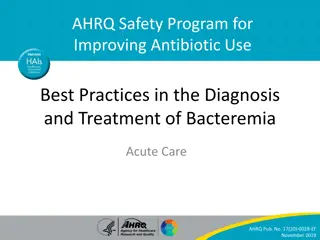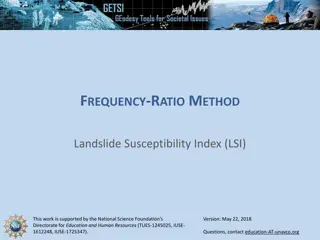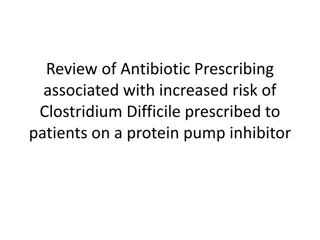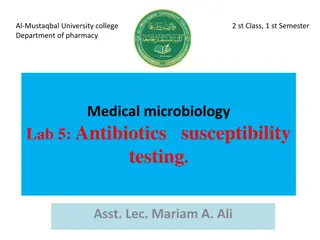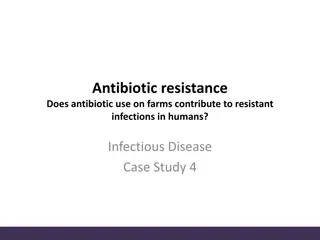Understanding MIC Breakpoints in Antibiotic Susceptibility Testing
Antibiotic susceptibility testing evaluates bacteria's response to antibiotics, aiding prescribers in drug selection by determining resistance levels. The interpretation involves categorizing results into S/I/R based on MIC breakpoints and growth inhibition zones. MIC values, ECOFF, PK/PD cutoffs, and the methodology for setting them play crucial roles in clinical decision-making.
Download Presentation

Please find below an Image/Link to download the presentation.
The content on the website is provided AS IS for your information and personal use only. It may not be sold, licensed, or shared on other websites without obtaining consent from the author. Download presentation by click this link. If you encounter any issues during the download, it is possible that the publisher has removed the file from their server.
E N D
Presentation Transcript
Introduction to MIC breakpoints for AST interpretation ECOFF, PK/PD breakpoint, clinical breakpoint Alain Bousquet-M lou May 2022
Antibiograms Objectives of antibiograms To evaluate the in vitro susceptibility of a given bacteria to antibiotics To help prescribers for the selection of the drugs : by excluding antibiotics classified as RESISTANT Results obtained with antibiograms Classification S / I /R Diameters of growth inhibition zones Corresponding to threshold values of MIC = Breakpoints Antimicrobial agent MIC breakpoint (mg/L) Disk content ( g) Zone diameter breakpoint (mm) S 20 S 1 R > 1 R < 20 X Antimicrobial agent A, S. aureus Antimicrobial agent B, S. aureus 2 4 Y 26 23
CBP ALL ARE MIC VALUES From clinical trials (cure versus MIC, very rare) From MIC distributions COCL Clinical cut-off [ [ ECOFF Epidemiological cut-off PK/PD cut-off From PK/PD approach
Organisation Epidemio PK/PD Clinics Decision CLSI/VAST COWT COPD COCL CBP EUCAST ECOFF PK/PD breakpoint CBP VETCAST ECOFF PK/PD cutoff COCL CBP
Epidemiological cut-off value (ECOFF) ECOFFs are is related to the distribution of MICs of wild type organisms lacking acquired or mutational resistance to the antimicrobial agent in question. The ECOFF is essentially the upper MIC value of the wild type distribution.
S R ECOFF
PK/PD cut-off value PK/PD cut-off is the highest MIC for which the critical value of the selected PK/PD index will be achieved in a given (high) percentage of the animal population treated This % of animals for which we want to attain the target value of the PK/PD index is called : Probability of Target Attainment (PTA) The % required is decided, often fixed at 90% : PTA>90%
Methodology for setting a PK/PD cut-off : the general case Step1 Selection of a PK/PD index predictive of clinical efficacy and/or prevention of resistance The setting of a COPK/PD Step 2 Determination of the critical value (size) of the selected PK/PD index (the target) Step 3 Computation of the percentage of animals in which the critical (target) value of the selected PK/PD index will be achieved (Probability of Target Attainment, PTA>90%) for a given animal species, for a given dose, and for all MICs in a given range
Methodology for setting a PK/PD cut-off : for a BETA-LACTAM Step1 FIXED The PK/PD index predictive of clinical efficacy is T > MIC The setting of a COPK/PD Step 2 VARIABLE The selected critical value (size) of T > MIC is 40% of dosage interval Step 3 Computation of the percentage of animals in which the critical (target) value of the selected PK/PD index will be achieved (Probability of Target Attainment, PTA>90%) for a given animal species, for a given dose, and for all MICs in a given range
Methodology for setting a PK/PD cut-off : for a TETRACYCLINE Step1 FIXED The PK/PD index predictive of clinical efficacy is AUC/MIC The setting of a COPK/PD Step 2 VARIABLE The selected critical value (size) of AUC/MIC is 125h (Average conc. = 5 x MIC) Step 3 Computation of the percentage of animals in which the critical (target) value of the selected PK/PD index will be achieved (Probability of Target Attainment, PTA>90%) for a given animal species, for a given dose, and for all MICs in a given range
For each possible MIC of the bacterial species : Is it possible to reach the critical values of the PK/PD index with the recommended dosage ? Plasma concentrations Area24h under the curve / MIC (AUC24h/ MIC) MIC Time > MIC (T > MIC) Time But why speaking about percentage of animals ?
But why speaking about percentage of animals (PTA) ? Because of the inter-individual variability of PK : the same dosage does not gives the same concentrations in different individuals Plasma concentrations MIC Time
But why speaking about percentage of animals (PTA) ? Because of the inter-individual variability of PK : the same dosage does not gives the same concentrations in different individuals Plasma concentrations MIC Time Population pharmacokinetic studies (POP PK) are required to determine the inter-individual variability of PK
Comparison of ECOFF and PK/PD cut-off S ECOFF R
Comparison of ECOFF and PK/PD cut-off S ECOFF R S PK/PDco R
S PK/PDco R
Comparison of ECOFF and PK/PD cut-off S ECOFF R
Comparison of ECOFF and PK/PD cut-off S ECOFF R PK/PDco
S PK/PDco R
